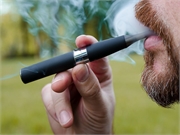- Navigating Your Midlife Crisis: Embracing New Possibilities
- City Raccoons Showing Signs of Domestication
- Mapping the Exposome: Science Broadens Focus to Environmental Disease Triggers
- One Week Less on Social Media Linked to Better Mental Health
- Your Brain Changes in Stages as You Age, Study Finds
- Some Suicide Victims Show No Typical Warning Signs, Study Finds
- ByHeart Formula Faces Lawsuits After Babies Sickened With Botulism
- Switch to Vegan Diet Could Cut Your Greenhouse Gas Emissions in Half
- Regular Bedtime Does Wonders for Blood Pressure
- Dining Alone Could Mean Worse Nutrition for Seniors
Animal Study Points to Heating Coil Behind Serious Vaping Injuries

The type of heating coil used in an e-cigarette and the amount of voltage sent through it could be contributing to vaping-related lung injuries, a new animal study contends.
Laboratory rats suffered lung injuries when exposed to vapor from devices using high-powered heating coils made of nickel-chromium alloy, something that did not occur in earlier experiments using stainless steel heating coils, researchers report.
“When we looked at their lungs, we saw they had very severe damage to the lung structure,” said lead researcher Michael Kleinman, a professor of occupational and environmental medicine at the University of California, Irvine. “We found we got the worst effects in coils that contained nickel and chromium, which is a typical kind of coil.”
E-cigarettes turn liquid into vapor using a heating coil similar to those found in toasters, Kleinman said. The coil is surrounded by the liquid, and when voltage is sent through the coil, it rapidly heats up.
Kleinman and his colleagues were doing vaping research on lab rats using devices equipped with stainless steel coils when they made their discovery.
The manufacturer stopped making the specific device they were using, so they had to switch to a compatible model that used nickel-chromium coils, Kleinman recalled.
“When we got the new coils and we ran them at the high power settings, we immediately noticed after the first set of exposures, the animals were literally gasping for breath,” he said. “They were lying on the bottom of the cages, just huffing and puffing. Their color looked off. Their nose, which is normally pink, kind of looked pale.”
Kleinman noted that the rat experiment used an e-liquid that was a 50-50 blend of propylene glycol and vegetable glycerin (the two main ingredients in most such liquids), with a little tobacco flavor added in. It did not include nicotine, THC or vitamin E additives.
E-cigarette advocates countered that these sort of experiments achieve their results by operating vaping devices in ways no consumer ever would.
“It’s under conditions that normal e-cigarette users would never use,” said Lindsey Stroud, a board member of the Smoke Free Alternatives Trade Association. “An e-cigarette user isn’t going to use a product if it’s burning. They’re going to taste it burning.”
She added that the most popular e-cigarette products — pod-based or disposable — do not have power settings that can be changed by the user.
“Any of your pod-based devices, you really can’t change how you heat it,” Stroud said. “This is done under really strict conditions to get these results.”
However, the American Lung Association says this study is a perfect example of why the U.S. Food and Drug Administration needs to regulate these products more tightly.
“The FDA has the opportunity to take research like this and only permit products that demonstrate their design is appropriate for the protection of the public health,” said Erika Sward, assistant vice president of national advocacy for the lung association. “It’s very clear that the higher wattage is going to be a problem, so as they review products they can say, this is our limit. We’re not going to allow any products that have a wattage greater than X to remain on the market.”
Sward said regulation needs to extend beyond the sort of liquid used in e-cigarettes and consider the entire design of each device.
“We don’t know enough about the products that people are then using to inhale chemicals into their lungs,” she said. “I think really this is the tip of an iceberg. It’s not only the chemicals that people are inhaling in their lungs, but it’s also what the devices are made of and their heat and the wattage associated with it, the type of battery — all of these things come together. The FDA really has to look at this and recognize that as former [U.S. Centers for Disease Control and Prevention] Director Tom Frieden said, these products are guilty until proven innocent. This kind of research adds more count to their guilty charge.”
Kleinman said there are a couple of potential reasons why nickel-chromium coils operated at high voltage might produce toxic vapor.
It could be that the type of metal, the high voltage and the primary components of e-liquid combine to create a toxic chemical reaction.
“There are chemical reactions that occur at these high temperatures, and some of the glycols polymerize to form new compounds,” Kleinman said. “It’s possible some of these compounds could have been oxidized or become toxic in one way or another.”
It’s also possible that the overheated metal could be shedding particles into the vapor.
“The coils when they heat up can shed metal ions, so there could be iron and nickel and other things” shed while vaping, Kleinman said. “Stainless steel tends to be less prone to staining or oxidizing, whereas the nickel-chromium coils more readily oxidize.”
The new research was recently published in the Journal of the American Heart Association.
More information
The U.S. Surgeon General has more about e-cigarettes.
Source: HealthDay
Copyright © 2025 HealthDay. All rights reserved.










